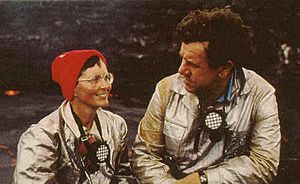Katia and Maurice Krafft facts for kids
Quick facts for kids
Katia and Maurice Krafft
|
|
|---|---|
 |
|
| Born | April 17, 1942 (Katia), March 25, 1946 (Maurice) |
| Died | June 3, 1991 (aged 49) (Katia) June 3, 1991 (aged 45) (Maurice) |
| Cause of death | Killed by the 1991 eruption of Mt. Unzen |
| Nationality | French |
Katia Krafft (born Catherine Joséphine Conrad, 1942–1991) and her husband, Maurice Krafft (1946–1991), were famous French volcanologists. They spent their lives studying and documenting volcanoes around the world.
Sadly, they died together on June 3, 1991, during a volcanic eruption at Mount Unzen in Japan. They were caught in a fast-moving cloud of hot gas and ash called a pyroclastic flow. The Kraffts were known for getting very close to volcanoes to film and photograph them. Their work helped many people understand the power and danger of volcanoes.
Contents
Early Life and Meeting
Katia's Early Life
Katia Joséphine Krafft was born on April 17, 1942, in Guebwiller, France. She was very smart and studied physics and chemistry at the University of Strasbourg. These subjects helped her understand how volcanoes work.
Maurice's Early Life
Maurice Krafft was born on March 26, 1946, in Mulhouse, France. He became interested in volcanoes when he was only seven years old. This happened during a family trip to Naples and Stromboli, where he saw volcanoes up close. By age 15, he had already joined the Geological Society of France. He later studied geology at the University of Strasbourg.
Katia and Maurice met at the university. They fell in love and got married in 1970. They didn't have much money at first. But they saved up for a trip to Stromboli, an active volcano. They took many photos of its eruptions. People were very interested in their pictures and films. This made them realize they could make a career out of documenting volcanoes. This career allowed them to travel all over the world.
Their Amazing Career
The Kraffts were often the first people to arrive at an active volcano. Other volcanologists respected and admired their bravery. Their videos and photos of eruptions were very important. They helped local leaders understand the dangers and convince people to leave unsafe areas.
For example, in 1991, Mount Pinatubo in the Philippines started to become active. The Kraffts showed videos of a past eruption in Colombia (from Nevado del Ruiz). This video helped convince many people, including the Philippine President, that they needed to evacuate. This saved many lives.
Katia started her work by collecting gas samples from volcanoes. She also watched eruptions in person and wrote many books about what she found. This was a new way to share information about volcanoes. She even made a documentary called "The Volcano Watchers" for a TV show.
In 1973, Katia went to Iceland to study a volcano that suddenly erupted after thousands of years. Many scientists were scared to get close to active volcanoes. But Katia was fearless. She would go right to the edge to get her observations. This bravery made her famous.
Throughout the 1970s and 1980s, Katia took amazing photographs. Maurice filmed the eruptions. Their observations helped scientists understand volcanoes much better. Katia took measurements, gas readings, and collected rock samples very close to erupting volcanoes. She also documented how eruptions affected the environment. She saw new volcanoes being formed and studied the effects of acid rain and ash clouds.
One of her last projects was about understanding volcanic dangers and reducing risks. Katia pushed boundaries to get her information. She wore a special helmet to protect herself from falling rocks. She even took a raft into a lake of acid to get readings! Her photos helped her work with governments to create safety plans and evacuation procedures. In 1969, Katia won an award for her early work on active volcanoes.
The Mount Unzen Eruption
In June 1991, Katia and Maurice were filming eruptions at Mount Unzen in Japan. They were standing on a ridge, watching the volcano. Suddenly, a pyroclastic flow changed direction. It swept over the ridge where they were standing.
They were killed instantly, along with 41 other people. This group included another volcanologist named Harry Glicken, firefighters, and journalists.
The Kraffts' work was shown in a National Geographic video. It included many of their films and photos. Maurice once said in that video, "I am never afraid because I have seen so many eruptions in 23 years that even if I die tomorrow, I don't care." This shows how dedicated they were to their work.
Their Legacy
A volcanic crater on the Piton de la Fournaise volcano, located on the island of Réunion, is named M. and K. Krafft Crater after the couple. Lava erupted from this crater in 1998.
The Krafft Medal is a special award given every four years. It honors the Kraffts' memory. It is given to someone who has greatly helped communities affected by volcanoes.
The Maurice and Katia Krafft Memorial Fund
The Centre for the Study of Active Volcanoes at the University of Hawaii at Hilo created a fund in their memory. It is called The Maurice and Katia Krafft Memorial Fund. Donations to this fund help teach people in areas with high volcanic risk about the dangers of active volcanoes.
Books
Katia and Maurice Krafft wrote many books together and separately. These books shared their incredible experiences and knowledge about volcanoes with the world.
See also
 In Spanish: Maurice y Katia Krafft para niños
In Spanish: Maurice y Katia Krafft para niños

